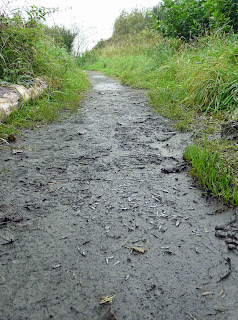Shakespeare’s King Lear reckoned winter lasted until at least their departure. The cold has kept us indoors but Druridge Bay is exquisite in winter. Thursday morning I was up at Blakemoor and Ellington, the pastures still empty of ewes and lambs, the arable fields with bedraggled winter wheat rotting away. The North Sea has been churned all weak into a deep iron blue. Theatrical sheets of snow whipped in, the sort of snow dry as polystyrene bobbles, bouncing off jackets and hats. The easterly blast blew in some surpirses; a taxidermist asking me if i'd seen his friend who he'd lost searching for the wreck of puffins that has been washing up all week. The final snow wall was trailed by a barn owl, drifting in on the eddies behind the snow front. I was out doing the first complete census check of ponds. As usual there were surprises, many of the shallower sites dried out but many of the tiny pools and ruts in gateways more conspicuous. the number and extent of ponds chnages significantly with season and year, which begs some tricky questions for surveys which rely on just one snap-shot visit in one year. A few dollops of frog spawn wallowed unconvincingly. We are keen to get out and collect a full range of sediment cores from across the range of pond types, but have been waiting for some new corers after our experiments with open sided screw-cores out of which the runnier top sediments dribbled (see 1st March blog). This has left Scott and Pete largely stuck in front of computer screens. However Dave Cooke has been welding and forging a new design. If the wild geese ever leave we will soon be back out.

Druridge Bay, an eight mile arc of sand running north from Cresswell to the harbour of Amble in Northumberland, strewn with wetlands. From lagoons stained the deepest green by summer algae to flooded tyre ruts, glinting water in the arable fields. This blog is a snapshot of research at the University of Northumbria as we explore this pondscape forged between northern sea and sky.
Friday, 29 March 2013
Sunday, 10 March 2013
Wrong place, wrong time
The deluge and floods of 2012 have barely receeded, both from memory or the landscape and winter has lingered on into early March. Here is a stiking recollection from last summer; the scatter of silver shards are a shoal of sticklebacks marooned and doomed on the path to the hides at Druridge Pools. The water had overwhelmed drains and ditches, creating a single washland from the Pools across to the dune tracks. These sticklebacks had ventured out beyond their orginal home, as all species have to, at least some individuals (see blog 19th November for flying molluscs, 12th Jan for airborne pondweed) . This swarm's bad luck left them in trackway puddles as the high water receeded. Reminds me of those fossil fish beds in museums, which conjure up a picture of ancient pools and their floundering inhabitants. I quite often splash through scattering shoals on other paths and tracks around the Bay; adventurous sticklebacks seem ubiquitous. Others will have made it to new pools, their good fortune a curse for many of the invertebrates which are vulnerable to these voracious mini-hunters.
Friday, 1 March 2013
Pete explores pond types
Up at Druridge Bay the seasons are teetering. Winter’s sodden fields are still gluey wet, swathes of wheat shoots bedraggled or long dead. The calls of geese and the widgeons’ whistles carry in on the wind, but the robins are singing for spring and busy swarms of goldfinches decorate the headlines. There is a growing busyness. January and February have been relatively dry so we have started a central aim of our research: characterising how different pond types vary in their carbon capture. “Pond types” sounds like another quagmire as bad as lakes vs ponds in the last blog. How to describe ponds depends on what you want to know: could be done for their conservation value using scores for lists of invertebrates or plants, or by the nutrient levels or pond histories. We are starting with four broad types: (1) ponds in arable fields, which are usually temporary and support few plants, (2) ponds in pasture, often covered with fodder grasses but some amphibious species too, (3) the dune slacks and flashes overlying sand soil, vulnerable to occasional brackish overflows and (4) the permanent, plant rich wetlands. The photos show Pete coring a grass ley and amongst dune slacks at Blakemoor. Sounds easy but we have hit a snag immediately. The corer works well, screwing down into the mud but when we gently teased it out the top layers of mud dribble out. These upper layers are especially dark and rich in organic debris, we must capture their presence in the samples. Research is like that. Sounds easy, go out, drill in a core, take out the sediment, go back to the lab..... I like the practical struggle, working out how to engineer the equipment, which is often more a visit to B&Q DIY than Large Hadron Collider.
The recce proved useful though, revealing dark, perhaps anoxic mud under the apparently normal sediment surface of the grassy ponds and the distinctly sandy soils underlying the dune slacks. The photo above shows the grainy sand to the right in a core from the dune slacks under about 10cm of gooier mud.
Subscribe to:
Comments (Atom)




